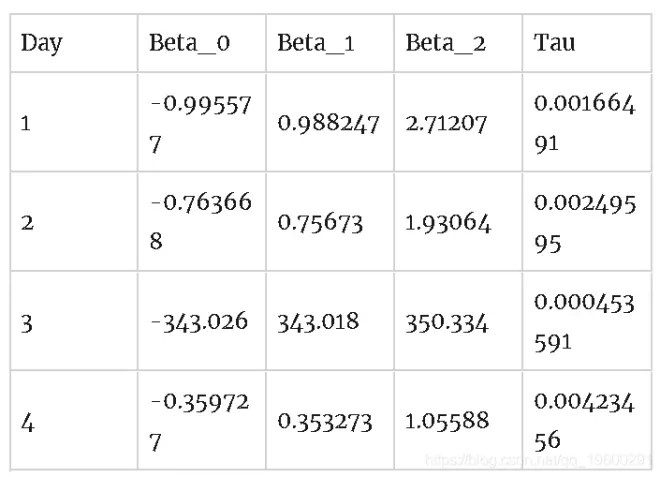R语言和QuantLib中Nelson-Siegel模型收益曲线建模分析
原文链接:http://tecdat.cn/?p=11803
Nelson-Siegel- [Svensson]模型是拟合收益曲线的常用方法。它的优点是其参数的经济可解释性,被银行广泛使用。但它不一定在所有情况下都有效:模型参数有时非常不稳定,无法收敛。
纳尔逊(Nelson)和西格尔(Siegel)在其原始论文中从远期利率入手,然后推导了收益率至到期曲线的公式.

Nelson-Siegel模型是简约的,可以生成丰富的收益曲线。
但是,由于简单地使用它,它通常失去了经济上的可解释性,甚至无法收敛。

上图显示了这种情况。
plot(MATURITY_BASES, oldYieldslines(MATURITY_BASES, oldYields)points(newMats, newYields, col="blue")lines(newMats, newYields, col="blue")
此代码模仿了一个频繁使用的案例,当前的收益曲线与昨天的曲线进行了比较。从某种意义上讲,这是一个简单示例,因为对于给定的到期日,我们已经具有零收益率。实际上,我们通常与票息债券有关,这会使事情变得更加复杂。
您可能会认为,由于软件的实施而导致收敛失败。我要讲的不是不好的实现,而是要高度依赖所使用的数值方法,如下面的更实际的示例所示。
提供更逼真的建模
#include <ql/qldefines.hpp>#ifdef BOOST_MSVC# include <ql/auto_link.hpp>#endif#include <ql/termstructures/yield/fittedbonddiscountcurve.hpp>#include <ql/termstructures/yield/piecewiseyieldcurve.hpp>#include <ql/termstructures/yield/flatforward.hpp>#include <ql/termstructures/yield/bondhelpers.hpp>#include <ql/termstructures/yield/nonlinearfittingmethods.hpp>using namespace QuantLib;int main(int, char*[]) {try {Calendar calendar = NullCalendar();Date today = Date(18, December, 2017);Settings::instance().evaluationDate() = today;//市场数据double cleanPrices1[] = { 107.96, 135.88, 110.6, 133.46, 135.8, 142.155, 121.045, 134.97, 117.04,101.61, 128.67, 106.615, 106.36, 99.515, 101.21, 105.655, 114.828 };double cleanPrices2[] = { 107.9, 134.965, 110.37, 132.89, 135.62,140.845, 120.585, 133.995, 116.745,101.58, 128.115,105.985, 105.395,99.385, 100.79,104.955, 114.7985 };double cleanPrices3[] = { 107.96, 134.625, 110.58, 132.65, 135.145, 140.585, 120.385, 133.735, 116.635,101.62, 127.925, 105.6, 105.085, 99.29, 100.6, 104.945, 114.7415 };double cleanPrices4[] = { 107.78, 134.39, 110.175, 132.445, 134.905, 139.515, 120.115, 133.475, 116.455,101.58, 127.845, 105.53,104.805, 99.07, 100.46, 104.885, 114.6225 };std::vector<boost::shared_ptr<BondHelper> > bondHelpersA;std::vector< boost::shared_ptr<SimpleQuote> > quoteA;std::vector<boost::shared_ptr<BondHelper> > bondHelpersB;for (Size i = 0; i < numberOfBonds; i++) {boost::shared_ptr<SimpleQuote> cp1(new SimpleQuote(cleanPrices1<em class="d4pbbc-italic"></em>));quoteA.push_back(cp1);boost::shared_ptr<SimpleQuote> cp2(new SimpleQuote(cleanPrices2<em class="d4pbbc-italic"></em>));quoteB.push_back(cp2);boost::shared_ptr<SimpleQuote> cp3(new SimpleQuote(cleanPrices3<em class="d4pbbc-italic"></em>));quoteC.push_back(cp3);boost::shared_ptr<SimpleQuote> cp4(new SimpleQuote(cleanPrices4<em class="d4pbbc-italic"></em>));quoteD.push_back(cp4);}RelinkableHandle<Quote> quoteHandleA[numberOfBonds];//Nelson-Siegel模型拟合Real tolerance = 1.0e-14;Size max = 10000;boost::shared_ptr<FittedBondDiscountCurve> tsA(new FittedBondDiscountCurve(curveSettlementDays,calendar,instrumentsA,ActualActual(),NelsonSiegelFitting(),tolerance,max));boost::shared_ptr<FittedBondDiscountCurve> tsB(new FittedBondDiscountCurve(curveSettlementDays,calendar,instrumentsB,ActualActual(),NelsonSiegelFitting(),tolerance,max));boost::shared_ptr<FittedBondDiscountCurve> tsC(new FittedBondDiscountCurve(curveSettlementDays,calendar,instrumentsC,ActualActual(),NelsonSiegelFitting(),tolerance,max));boost::shared_ptr<FittedBondDiscountCurve> tsD(new FittedBondDiscountCurve(curveSettlementDays,calendar,instrumentsD,ActualActual(),NelsonSiegelFitting(),tolerance,max));std::cout << tsA->fitResults().numberOfIterations() << std::endl;std::cout << tsB->fitResults().numberOfIterations() << std::endl;
正式而言,收益曲线每天的变化并不显着,但是模型参数却可以:

Nelson-Siegel意识到了这些问题,并提供了解决这些问题的方法。特别是,他们考虑了Taus的时间序列,并确定了Taus的最佳拟合值的中值和合理范围。
但是,与往常一样,原始论文被引用的次数可能多于阅读次数。此外,如果需要按时间顺序排列的收益率数据,可能会感到困惑,而不是仅仅考虑相关日期的数据。即使处理时间序列不是问题,Nelson和Siegel也没有指定正式的算法来选择的最佳值。

最受欢迎的见解
1.在python中使用lstm和pytorch进行时间序列预测
2.python中利用长短期记忆模型lstm进行时间序列预测分析
3.使用r语言进行时间序列(arima,指数平滑)分析
4.r语言多元copula-garch-模型时间序列预测
5.r语言copulas和金融时间序列案例
6.使用r语言随机波动模型sv处理时间序列中的随机波动
7.r语言时间序列tar阈值自回归模型
8.r语言k-shape时间序列聚类方法对股票价格时间序列聚类
9.python3用arima模型进行时间序列预测

